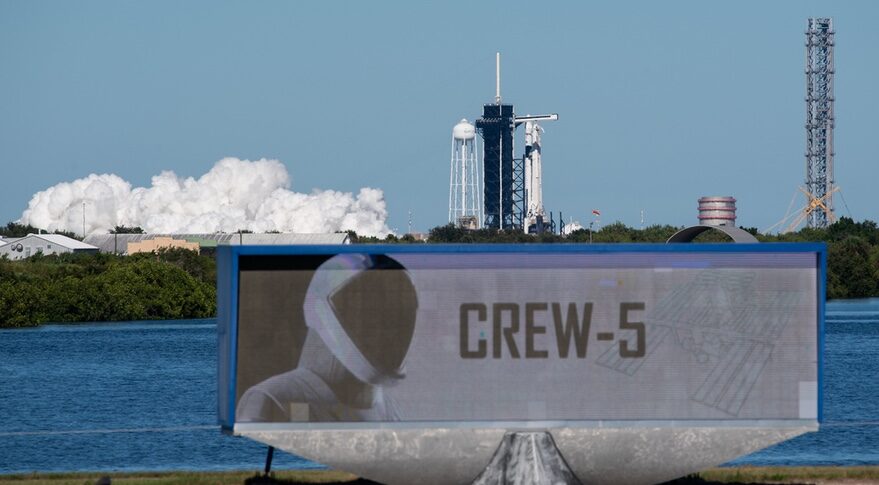KAHULUI, Hawaii — As SpaceX prepares to launch a new crew to the International Space Station from one pad at the Kennedy Space Center, it is starting work to upgrade another pad at Cape Canaveral as a backup.
NASA and SpaceX completed the launch readiness review Oct. 3 for the Crew-5 mission, currently scheduled for launch at 12 p.m. Eastern Oct. 5 from Launch Complex 39A. The mission will send NASA astronauts Nicole Mann and Josh Cassada, JAXA astronaut Koichi Wakata and Roscosmos cosmonaut Anna Kikina to the ISS for up to six months.
At an Oct. 3 briefing, Steve Stich, NASA commercial crew program manager, said the agency and SpaceX were working through three “open items” ahead of the launch, including replacing a thrust vector controller in one of the Falcon 9’s Merlin engines, fixing a leak in a fire extinguisher in the Dragon spacecraft and working on a communications issue that was affecting the ability of a SpaceX droneship to maintain position support the landing of the Falcon 9 booster.
None of the issues were “showstoppers” for a launch, said Benji Reed, senior director of human spaceflight programs at SpaceX, during the briefing. Weather is forecast to be favorable for the launch, with a 90% chance of acceptable conditions at the launch site but a “moderate” risk of unfavorable weather along the ascent corridor because of the remnants of Hurricane Ian.
The launch, like all previous Crew Dragon missions, will take place from LC-39A. But as SpaceX continues work to host Starship launches from the same complex, company officials said they’re also starting work to host cargo and crew launches from Space Launch Complex 40 at neighboring Cape Canaveral Space Force Station.
At a Sept. 26 briefing, Bill Gerstenmaier, SpaceX vice president for build and flight reliability, said the company had already started preparations for the upgrades needed at SLC-40 for cargo and crew launches. “We’ve already started the work to begin the preparations for pad 40. We’ve ordered some hardware, put some contracts into place,” he said.
He didn’t elaborate on the work needed to prepare SLC-40 for cargo and crew missions. “We’ll do cargo first. We can do that fairly easily,” he said. “It gives us some flexibility to move some things off 39A, which helps us balance launches off both pads. We’ll add crew at the right time.”
SpaceX originally launched cargo Dragon missions from SLC-40. However, when the company moved to the second-generation cargo Dragon, based on the Crew Dragon spacecraft, those launches all moved to LC-39A, which has a gantry and crew access arm to provide access to the spacecraft until just before launch.
The effort to build up a crew and cargo capability at SLC-40 is driven by SpaceX’s work to host Starship launched at LC-39A. With that vehicle yet to make its first orbital launch attempt, NASA raised concerns that a Starship launch failure at LC-39A could damage the existing launch infrastructure there and affect NASA’s ability to send cargo and crews to the ISS.
“We are beginning to follow the activities at Pad 39A relative to Starship,” said Steve Stich, NASA commercial crew program manager, noting it came up during the flight readiness review that took place before the Sept. 26 briefing. “We are looking at options of having a crew capability at 40.” He said later that NASA was following SpaceX’s plans “each step of the way.”
Gerstenmaier said that while construction is underway at LC-39A to host Starship launches, no launches of that vehicle are imminent from the pad. “Our intent is to bring Starship to 39A after we have a reliable vehicle. We’ll do a series of tests in Boca [Chica] to makes sure the vehicle is ready to go. When we think we have a good and reliable vehicle, we’ll bring it to 39A.”
It’s unclear when a “good and reliable” Starship will be ready to fly from LC-39A. SpaceX has continued testing of Starship prototypes at its Boca Chica, Texas, test site, including static-fire tests of the Starship vehicle and its Super Heavy booster, but has not set a launch date for an initial orbital flight attempt.
Elon Musk, founder and chief executive of SpaceX, tweeted Sept. 21 that an orbital launch attempt could take place as soon as late October, “but November seems highly likely.” Musk has made many predictions, though, of an orbital launch of Starship, including at a September 2019 event when he predicted Starship would make an orbital launch by mid-2020.
Musk tweeted Aug. 2 that he expected a first successful orbital flight of Starship any time from 1 to 12 months. The company has yet to secure a launch license from the Federal Aviation Administration for a Starship orbital launch, although it did pass an environmental review with conditions in June.

